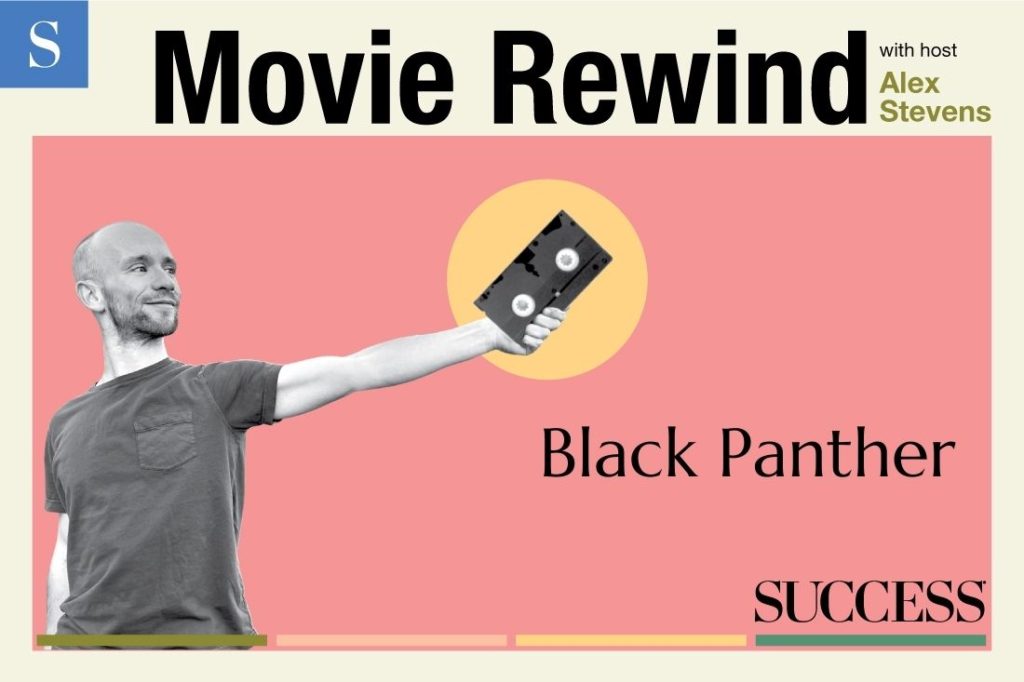Welcome back to SUCCESS Movie Rewind, everyone. This is a great week because we have a great movie for you: Black Panther. The 2018 hit Marvel Studios film was more than a superhero movie: It was the first Marvel movie with a Black director, and it quickly became what was then the highest grossing superhero movie of all time in the U.S.
My personal experience seeing this film was certainly in line with those accolades. My fellow movie-goers were loving it, and others were lining up to take selfies next to the movie poster outside. Black Panther was nothing short of a cultural moment, and the filmmakers and cast gave us a movie worthy of that moment.
Even if you’re not inclined to see superhero movies and you’re more into focusing on the real world today, stick around. We’ve got a fantastic discussion about some of the personal development lessons from this movie for you, and I promise you’ll enjoy it. Let’s get into it.
Lesson 1: There’s no peace in hiding your power
Unlike some of our recent movie discussions, this one is not going to be spoiler-free. It’s going to be spoiler-full, and that’s probably OK since you’ve probably already seen this movie. And if you haven’t, this is your chance to go watch it.
With that out of the way, let’s jump into lesson one: There’s no peace in hiding your power. In the film, the nation of Wakanda is the most technologically advanced on earth. Using the fictional, energy-bending vibranium ore, Wakandans have created some of the foremost civil and military innovations humanity has ever seen.
There’s one problem: Much of humanity has never seen these technological marvels. That’s because Wakanda is trying to conceal its power and capabilities from the outside world. They put a lot of effort into it and achieve an impressive degree of success. But the relative peace that privacy has afforded the Wakandans comes crashing down when the events of the film unfold.
Why? Because there’s no peace in hiding your power. There’s only temporary respite. Applied in the real world, hiding your power might mean staying quiet when you have great ideas because you know your boss will want to shoot them down. It might mean having a potentially world-changing business idea and sitting on it because you think the world won’t change with you.
In the short term, you don’t have to face your boss’ criticism or the struggles of being a founder. But in the long term, you’re left with the same world, the same systems and the same situations unless you do something to change them.
Lesson 2: The truth has no maintenance fees
We get a lot of backstory to support the big moments in Black Panther, and that leads to some pretty powerful exchanges between the characters. One of the biggest pieces of backstory we get is the king of Wakanda, T’Chaka, confronting his brother, N’Jobu, in Oakland, California, about stealing vibranium from Wakanda.
A scuffle ensues, and in the chaos, T’Chaka kills his brother, N’Jobu. That left N’Jobu’s son, N’Jadaka (Erik “Killmonger” Stevens), an orphan. In the film’s present day, we see Stevens, now known as Killmonger, return to confront T’Chaka’s son, T’Challa, who is now the king of Wakanda. The basic plot of the film unfolds from there, and much of it is the result of certain Wakandans trying to “maintain the lie,” as one character puts it.
The lie could be the vision of Wakanda as this united front with no internal strife, or it could be the image Wakanda is trying to get the world to believe—one of subsistence farming and little technology or international power. In either case, characters are going to great lengths to maintain those lies.
The truth, however, has no maintenance fees. When you tell the truth about yourself and stop trying to hide certain aspects of your character, beliefs or passions, you don’t have to maintain any lies. You can focus on who you are and what you want out of life.
Lesson 3: See the people behind the symbols
In Black Panther, we’re presented with a battle of ideologies. Our hero and villain—although many have said Killmonger isn’t as much of a villain as he may be painted to be—have different approaches to leveraging Wakanda’s power, and they come to a point of world-changing conflict over it.
One of those viewpoints would involve quite a bit more violence than the other if it were allowed to play out. And while the ideology on paper is a noble one, that threat to real people is inescapable. However, it’s easy for Killmonger—who has suffered immensely throughout his life—to forget the real people behind the symbols of his ideology and approach.
No matter how noble your approach to whatever it is you’re doing—running a company, climbing the ladder, writing a book—feels to you, you have to always remember that there are people behind the symbols you see along your journey. You may see obstacles where real people are actually standing, and if you don’t take the time to understand that, you’ll get to the top with a lot of pain and damage in your wake.
See the people behind the symbols and save yourself the pain of harming others in your pursuit of success.
That’s all we’ll get into for Black Panther today. There’s so much more to discuss, but we only have so much time, and I’d rather you take the extra time to go give this one a watch or rewatch. See you next week.











